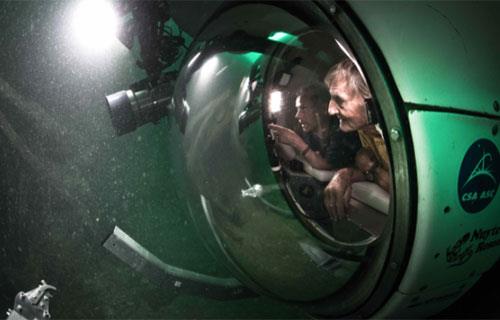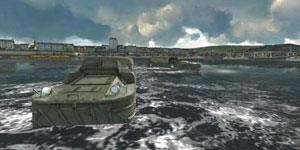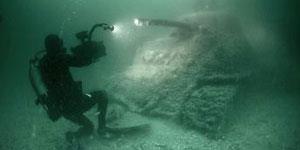
[Editor's Note: TVWW contributor Donna J. Plesh died April 2, 2015, from ovarian cancer. She was 71. Donna covered television since the early 1980s, initially for the Orange County Register and its TV magazine. She also was a member of the Television Critics Association. Donna was always a cheerful spirit within the TVWW network and often gave readers a kind, up-close viewpoint in her interviews with a wide variety of television stars. She will be missed.]
June 6 marks 70 years since Allied forces landed along the beaches of France’s Normandy coast to begin the daunting task of retaking much of Europe from Nazi forces. Thousands of Allied troops lost their lives during the invasion on the day we now know as D-Day.
On Wednesday, May 28 at 9 p.m. ET on PBS (check local listings), NOVA presents the documentary “D-Day’s Sunken Secrets.” The documentary follows an expedition team, led by Sylvain Pascaud (who also explored the wreck of the Titanic many times), surveying the seabed off the coast utilizing divers, submersibles, small submarines and advanced sonar devices to search for the so-called lost fleet of ships that brought troops to the beaches. The team is composed of oceanographers, historians and underwater archaeologists. In addition, some veterans of the invasion visit the site and share their memories, adding a very human dimension to the documentary.
There were more aspects to the D-Day invasion than most of us learned in school, as the program’s producer, director and writer Doug Hamilton said in a Television Critics Association press tour interview in January.
“We tend to think of D-Day from the perspective of the beach, the Saving Private Ryan and all of those Stephen Ambrose books that have focused on the incredible heroism at that time, but the operation itself went on for two months," he said.
 "So I think looking at D-Day from the perspective of the beach and seeing all the wrecks that are out there gives us a new perspective to understanding how it actually transpired. Beyond that, what Sylvain (Pascaud) and his team are doing is correcting the historical record that’s out there. A lot of the information that exists is wrong, and we’ve been able to show that. And these wrecks are disappearing, and so it’s the creation of a document, in a sense, of what’s there that can be studied by historians like Adrian [Lewis, History professor at the University of Kansas and retired U.S. Army officer who has written a book on Omaha Beach] forever now,” said Hamilton.
"So I think looking at D-Day from the perspective of the beach and seeing all the wrecks that are out there gives us a new perspective to understanding how it actually transpired. Beyond that, what Sylvain (Pascaud) and his team are doing is correcting the historical record that’s out there. A lot of the information that exists is wrong, and we’ve been able to show that. And these wrecks are disappearing, and so it’s the creation of a document, in a sense, of what’s there that can be studied by historians like Adrian [Lewis, History professor at the University of Kansas and retired U.S. Army officer who has written a book on Omaha Beach] forever now,” said Hamilton.
Hamilton added that there are three focus points in the program.
“One, we’re talking about the history of the day, how it unfolded and that will be relatively chronological. We’re talking about the engineering story and what it took to prepare the troops for whatever their particular action was, whether that be the landing craft or these floating tanks or the gliders that went in, so you get a bit of that backstory. So maybe a third of the show is that.
"And then another third of the show is the expedition, and we’re weaving between them. It’s not just a straight chronology, but what NOVA really wanted to do in this was not just tell the history of what happened, but to participate in a way of seeing this battle more actively and to be a part of actually adding value to our understanding of what happened on D- Day, and hopefully that’s what the show will do. But it’s a mix of chronology as well as what we find on this expedition. “
The producers refer to the area they researched as an underwater battlefield. And as Professor Lewis said in an interview, underwater is truly a battlefield filled with remains of all types of sunken craft.
“If you take a look at the numbers, the sheer numbers of wrecks out there, I think that’s a bit surprising. In other words, if you look at the sweep of the area that they’ve covered and you see the numbers of wrecks, we have figures on casualties and we see the land war and you can see all those things, but what you don’t see is the number of tanks, LCTs (Landing Craft Tanks), and other ships that were destroyed and they’re laying there on the bottom. So what you do get is some sense of the magnitude of what was taking place there also,” he said.
Planning for the invasion in 1944 itself was a monumental task, and researching an expedition to its underwater battlefields was also very involved, said Hamilton.
“When we think of D-Day, we think of this incredible might — 5,000 warships, 6,000 airplanes. When you look at what went on in the planning, one of the first steps was really to understand the geography there. It’s a very unique part of the world. The English Channel has these incredible tidal ranges. It goes 25 feet twice a day. I shot with Adrian out on Omaha Beach. We arrived there at low tide, and we started filming, and he’s explaining what’s happening there. We are basically constantly walking back to avoid being submersed in this tide. If we had stayed in that same place and waited six hours, we would have been — let me do my math — 18 feet under water. So understanding the role that geography played in this invasion is an important part of the story and an important part for us to understand,” he said.

Expedition leader Pascaud said working underwater is far from easy, what with the changing weather and currents. “From a technical standpoint, I’ll add that finding things underwater and mapping things underwater is still a very difficult endeavor. It’s probably easier to find an iPhone in China than to know exactly where a wreck is. It’s strange, but that’s the case. In 2009, a 200-ton jet went down in the middle of the Atlantic between Rio and Paris. It took us 2 and 1/2 years to find it. And just creating this map is not something automatic. It’s something we had to be very creative about. It’s a combination of high tech and low tech, and it took us 30 days. So in terms of underwater mapping, we’re not there.
“We started in a humble way. We just looked for the information available. So we turned to the fishermen. We turned to the French navy, to the English to the Royal Navy as well. We got information, built a base map, and identified all the wrecks that were there. And then we started working, mowing the long thing, and then we just added layers. And then we tried to match our map with the past, and that’s how we found a 40 percent difference and how the wrecks basically were collapsing on themselves and being sort of disappearing in the sand. We surveyed 500 square kilometers, which is a 10 kilometer wide area by 50, and we got 400 targets, and we started off with basically 50 to 70 targets,” said Pascaud in an interview.

Sadly, many of those who survived the invasion itself have since died -- but not all. Bill Allen, who was a medic on LST (Landing Ship Tank) 523 and survived when his ship hit a mine, blew up and sank. At 88, Allen was invited back by the team and went down in a small research submarine to see the wreck of his ship. In an interview, Allen said there were 117 men on the ship and he was one of only 28 who survived.
Of his trip to the underwater battlefield, Allen said, “Well, it was certainly an experience that I had never had before. I had never been in a submarine. Very tight, the diameter of the sub must have been 6 or 7 feet at the most, more of an egg-shaped configuration. But I wanted to see my ship, and I was willing to pay the price. So we got in with the skipper and his assistant, and we went down to the bottom of the channel. When we came up, we had been down an hour and 15 minutes. But it was very exciting. It had a great meaning to me, but I had no fear because I was interested in seeing what was left of my ship.”
Though it has been many decades since the invasion, Allen still remembers much of what happened. “Well, the LST was a ship that went in to the beach. We would have to go in when the tide was in. We would drop anchor and then the tide would go out and leave us on dry land. We had to load and unload, but we had to do this before the tide came back in because that was when we would have to get off the beach, so we had about 12 hours of the time between the tide coming and going to load and unload. But the tide played a very important part when we actually beached and when we left the beach.
“But I do remember the events very plain. As we went in, we were all concerned, naturally. We knew that life could be very short, but somehow it seemed like we had an idea that it might happen. By the fourth trip, when we went in, we had begun to feel pretty sure of ourselves, that the battle, the fighting, was inland. We thought we had nothing much to worry about. But that was when one of those big swells went out, let us drop right down on this mine, and that was the end of the LST (523),” said Allen.